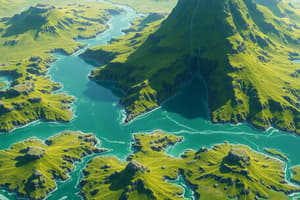Podcast
Questions and Answers
How do deltas develop? Choose one.
How do deltas develop? Choose one.
- When a small tributary enters the trunk stream
- When stream velocity increases the competence of streams
- When sediment-laden stream water enters standing water, like an ocean (correct)
- When an area of a stream becomes influenced by tides
Which type of delta is shown in the photo below?
Which type of delta is shown in the photo below?
Bird's-foot delta
Define the discharge of a stream. Choose one.
Define the discharge of a stream. Choose one.
- The amount of rainfall that enters a stream from a drainage basin
- The mass of water flowing through the entire stream at any given time
- The velocity of water flowing at the mouth of a stream
- The volume of water passing through a point on a stream per unit time (correct)
Why is the average velocity of a stream difficult to determine? Choose one.
Why is the average velocity of a stream difficult to determine? Choose one.
What factors cause the discharge of a stream to change? Choose one or more.
What factors cause the discharge of a stream to change? Choose one or more.
What is the difference between permanent streams and ephemeral streams?
What is the difference between permanent streams and ephemeral streams?
Which type of stream is shown in the photo below?
Which type of stream is shown in the photo below?
What is the difference between a stream's competence and capacity? Match the terms with their correct definitions.
What is the difference between a stream's competence and capacity? Match the terms with their correct definitions.
The size of the clasts that settle at a particular locality depends on how slow the flow has become. Therefore, (1)_________ sediment tends to settle out upstream, where water flows faster, whereas (2)__________ grains settle out downstream, where water flows more slowly, and the (3)_____________ sediment settles out when the stream flows into a standing body of water.
The size of the clasts that settle at a particular locality depends on how slow the flow has become. Therefore, (1)_________ sediment tends to settle out upstream, where water flows faster, whereas (2)__________ grains settle out downstream, where water flows more slowly, and the (3)_____________ sediment settles out when the stream flows into a standing body of water.
Does the land surface outside of the watershed slope toward or away from the drainage divide?
Does the land surface outside of the watershed slope toward or away from the drainage divide?
A stream will deposit sediment when __________.
A stream will deposit sediment when __________.
Stream sediment is deposited in a variety of settings. Which setting best describes the photo below? Choose one.
Stream sediment is deposited in a variety of settings. Which setting best describes the photo below? Choose one.
Label the sources of water that can enter a stream.
Label the sources of water that can enter a stream.
What is the difference between a slow-onset flood and a flash flood? Match the descriptions with their term.
What is the difference between a slow-onset flood and a flash flood? Match the descriptions with their term.
What weather conditions can lead to flooding? Choose one or more.
What weather conditions can lead to flooding? Choose one or more.
Downcutting in a stream __________ a channel, and headward erosion __________ a channel. Choose one.
Downcutting in a stream __________ a channel, and headward erosion __________ a channel. Choose one.
Label the location on this stream diagram where water is flowing fastest.
Label the location on this stream diagram where water is flowing fastest.
As a stream downcuts through alluvium, as shown in the diagram below, a new lower floodplain develops. The remnants of the original alluvial plain remain as a pair of _...
As a stream downcuts through alluvium, as shown in the diagram below, a new lower floodplain develops. The remnants of the original alluvial plain remain as a pair of _...
Flashcards
Delta Formation
Delta Formation
Landform created by sediment deposition where a stream enters standing water.
Bird's-foot Delta
Bird's-foot Delta
A delta with long, branching extensions.
Stream Discharge
Stream Discharge
Volume of water passing a point in a stream per unit time.
Human Impact on Discharge
Human Impact on Discharge
Signup and view all the flashcards
Factors Affecting Discharge
Factors Affecting Discharge
Signup and view all the flashcards
Permanent vs. Ephemeral Streams
Permanent vs. Ephemeral Streams
Signup and view all the flashcards
Stream Competence
Stream Competence
Signup and view all the flashcards
Stream Capacity
Stream Capacity
Signup and view all the flashcards
Sediment Settling
Sediment Settling
Signup and view all the flashcards
Watershed Slope
Watershed Slope
Signup and view all the flashcards
Sediment Deposition
Sediment Deposition
Signup and view all the flashcards
Stream Water Sources
Stream Water Sources
Signup and view all the flashcards
Slow-Onset vs. Flash Floods
Slow-Onset vs. Flash Floods
Signup and view all the flashcards
Flood Weather Conditions
Flood Weather Conditions
Signup and view all the flashcards
Downcutting vs. Headward Erosion
Downcutting vs. Headward Erosion
Signup and view all the flashcards
Downcutting
Downcutting
Signup and view all the flashcards
Headward Erosion
Headward Erosion
Signup and view all the flashcards
Importance of Stream Velocity
Importance of Stream Velocity
Signup and view all the flashcards
Study Notes
Deltas and Stream Formation
- Deltas form when sediment-laden stream water enters standing water, such as oceans, leading to sediment deposition.
- Bird's-foot delta is a specific type characterized by long, protruding branches resembling a bird's foot.
Stream Discharge and Measurement
- Stream discharge is defined as the volume of water passing through a specific point on a stream per unit time.
- Determining average stream velocity is complex due to often inaccurate measuring instruments.
Factors Influencing Stream Discharge
- Human activities, like irrigation, can alter stream discharge.
- Watershed size and precipitation levels (rain or snow) significantly impact discharge rates.
Permanent vs. Ephemeral Streams
- Permanent streams flow throughout the year, while ephemeral streams only flow during certain parts of the year.
- Ephemeral streams typically experience flow during specific seasons or rainfall events.
Stream Competence and Capacity
- Competence refers to the maximum particle size a stream can carry.
- Capacity indicates the total sediment quantity a stream can transport.
Sediment Settling Dynamics
- Coarser sediments settle upstream where flow is faster, while finer grains settle downstream, and the finest settle as the stream enters standing water.
Watershed Dynamics
- Land surface outside a watershed slopes away from the drainage divide, directing water flow towards the divide.
Sediment Deposition
- Streams deposit sediment when their flow velocity decreases, leading to sedimentation in various environments such as gentle streams and rivers entering larger bodies of water.
Water Sources to Streams
- Sources of water entering streams include puddles, swamps, lakes, groundwater, melting ice or snow, and precipitation.
Flood Types
- Slow-onset floods develop gradually over days, while flash floods can occur rapidly, causing swift rise in water levels that make escape difficult.
Weather Conditions Leading to Flooding
- Flooding can result from abrupt, heavy rains, prolonged rainfall, or rapid snowmelt during warm spells.
Stream Erosion Processes
- Downcutting deepens a stream channel, while headward erosion lengthens it, contributing to stream valley formation.
Stream Dynamics
- Identifying locations of fastest water flow in a stream is crucial for understanding erosion and sediment transport processes.
Studying That Suits You
Use AI to generate personalized quizzes and flashcards to suit your learning preferences.




